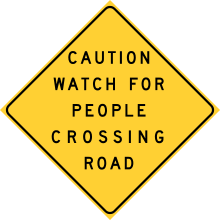Immigration sign
_-vector.svg.png)
The immigration sign is an American highway safety sign warning motorists to avoid immigrants darting across the road. It depicts a man, woman, and child with pigtails running. The signs were erected in response to over one hundred immigrant deaths due to traffic strikes from 1987 to 1990 in two corridors along Interstate 5 along the San Ysidro Port of Entry at the United States-Mexico border and approximately 50 miles (80 km) north at the San Clemente United States Border Patrol checkpoint in Camp Pendleton.[1]
Immigrant smugglers adopted the tactic of dropping off their human cargo on the shoulder or median of the freeway prior to passing through the checkpoint. Once past the checkpoint, the smugglers would wait for the immigrants to rejoin before proceeding to the final destination. However, in order to avoid the checkpoint (straddling the northbound lanes of the freeway), the immigrants would have to cross the freeway to the southbound shoulder. At the Camp Pendleton checkpoint, immigrants were precluded from passing the checkpoint on the northbound shoulder by rugged terrain and random Marine patrols.[1] The running family silhouette supplemented all-text signs advising drivers "CAUTION WATCH FOR PEOPLE CROSSING ROAD".[1]

Caltrans graphic artist John Hood, a Navajo Vietnam War veteran, created the image as an assignment in response to the sharp rise in immigrant traffic deaths.[2] The image was developed to elicit immediate recognition of the potential traffic hazard and to illustrate the potential running motion with the little girl's flowing pigtails.[2] The final design process took approximately a week, and Hood drew inspiration from both his experiences in Vietnam as well as stories from his Navajo parents.[3]
The running family silhouette signs were erected starting in September 1990,[3] and it is not known how effective they were in reducing traffic strike fatalities before the implementation of other physical measures. Eventually, Caltrans built a tall fence in the I-5 median south of the San Clemente checkpoint, which effectively precluded the checkpoint-avoidance traffic-crossing tactic at Camp Pendleton,[3] and the Border Patrol implemented Operation Gatekeeper in 1995, which erected a tall fence along the San Diego–Tijuana border, moving undocumented immigration attempts further east into the desert.[3]
It became a pop culture icon as it appeared on T-shirts and anti-immigration advertisements in various incarnations.[3] It was exhibited in the Smithsonian Institution's permanent exhibition on transportation,[3] and British street artist Banksy used a modified version of the silhouette family in his Kite-2 artwork exhibited on Los Angeles-area streets in early 2011.[4] The silhouette family is also a popular target of parody, spawning variants including ones where the family is depicted wearing caps and gowns (referencing the DREAM Act); as Joseph, Mary and Jesus;[5] and one where they are wearing Pilgrim gear.[3]
References
- 1 2 3 Mydans, Seth (7 January 1991). "One Last Deadly Crossing for Illegal Aliens". The New York Times. Retrieved 15 June 2015.
- 1 2 Gold, Scott (4 April 2008). "The artist behind the iconic 'running immigrants' image". Los Angeles Times. Retrieved 15 June 2015.
- 1 2 3 4 5 6 7 Berestein, Leslie (10 April 2005). "Highway safety sign becomes running story on immigration". San Diego Union-Tribune. Retrieved 15 June 2015.
- ↑ Rivas, Jorge (22 February 2011). "Banksy Transforms Migrant Road Sign into DREAM Crossing". COLORLINES. Retrieved 15 June 2015.
- ↑ Berestein Rojas, Leslie (5 March 2011). "Before Banksy, the running family was immigration icon and art". 89.3 KPCC. Retrieved 15 June 2015.
External links
- Will, George F. (19 August 1993). "OPINION: Free trade in the land of the free". Sarasota Herald-Tribune. Retrieved 15 June 2015.
- Arellano, Gustavo (6 July 2010). "The Five Best Parodies of the Illegal Immigrant Crossing Sign". OC Weekly. Retrieved 15 June 2015.
- Chua, Amy (16 December 2007). "The Right Road to America?". Washington Post. Retrieved 15 June 2015.
- Clingman, Brent (1 January 1989). "Sign on border between Mexico & CA reading Caution watch for people crossing road re illegal immigrants entering US & being killed by darting onto freeways". Getty Images. Retrieved 15 June 2015.